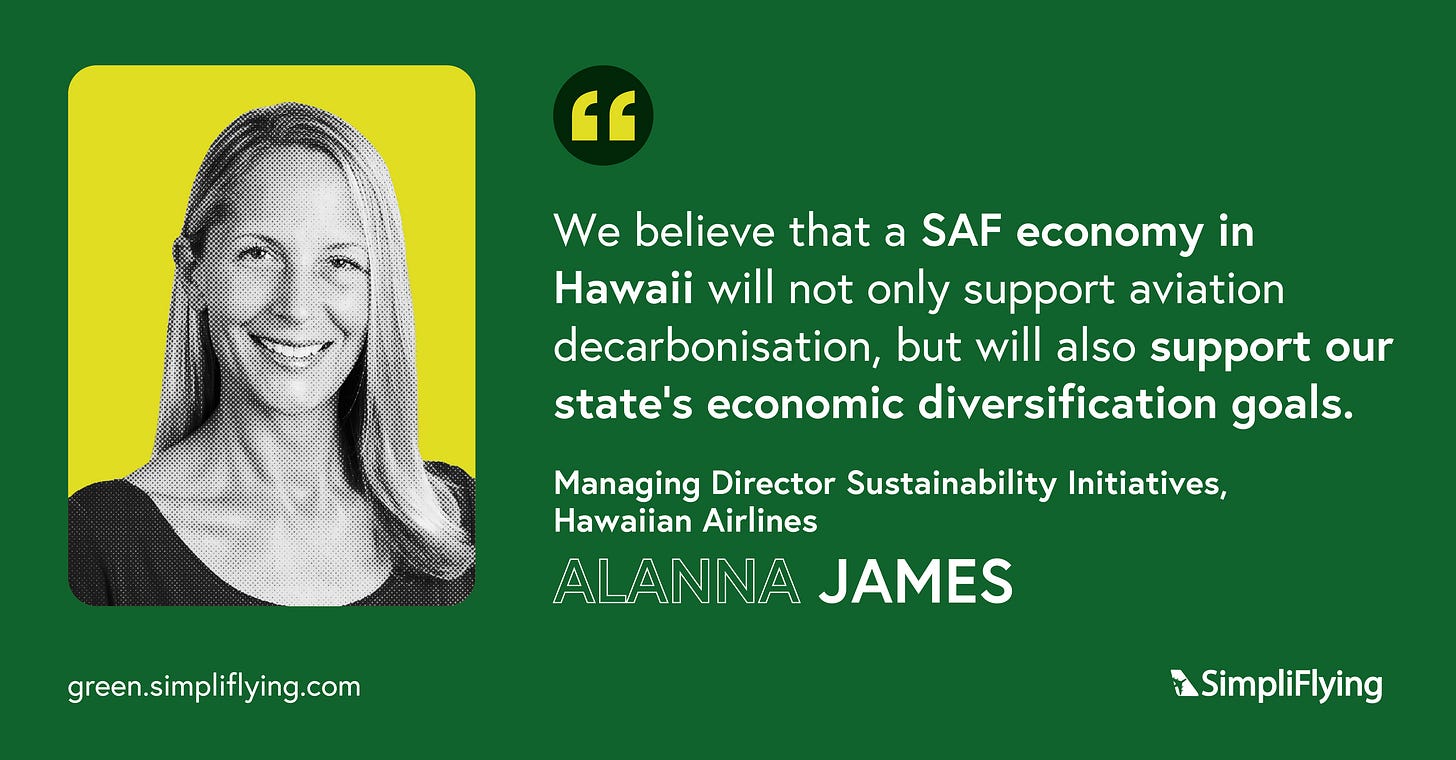In this episode of our 'Sustainability in the Air' podcast, Alanna James, Managing Director Sustainability Initiatives at Hawaiian Airlines, speaks with SimpliFlying's CEO Shashank Nigam and shares insights into the airline's distinctive approach to sustainability and the challenges of operating in an island environment.
At Hawaiian, James has worn many hats, from strategy and transformation to financial planning and analysis, overseeing regional business operations, and investor relations. This diverse experience within the company has equipped her to lead its sustainability initiatives at a critical time.
Here are the key highlights of the conversation:
Hawaiian Airlines’ unique sustainability challenges (2:52)
The critical role of Sustainable Aviation Fuel (SAF) in Hawaiian's strategy (8:53)
Partnerships for local SAF production (13:30)
Hawaiian's network and its reliance on SAF (18:28)
Investing in innovative technologies like electric sea gliders (28:15)
Operational efficiencies and fuel conservation initiatives (24:07)
Challenges and potential of hydrogen-powered aircraft (36:58)
Rapid Fire! (42:42)
Keep reading for a quick overview of the episode.
Why Hawaii’s unique geography and ecology matter
The enigma, aura and allure of Hawaii continue to ensure its global appeal. The ground reality, however, is a cluster of contradictions. For an island of merely 1.5m residents, the archipelago receives almost half that number each month as visitors, many of them possibly enticed by pristine images of beaches popularised by films and popular media.
That very image of Hawaii is now in danger. Troubling news emerges each week about how climate change is ravaging the islands. Declining rainfall, rising temperatures and invasive species have created the perfect storm for wildfires to thrive in; the iconic beaches are slowly disappearing; and dry regions are likely to get drier as wet areas get wetter. And in a glimpse at nature’s morbid sense of humour, millions of mosquitoes were recently released in Hawaii to save rare birds from extinction.
Headquartered in Honolulu, 94-year-old Hawaiian Airlines faces unique sustainability challenges due to Hawaii's geographic isolation and vulnerability to climate change. In fact, the core theme of Hawaiian Airlines' sustainability journey is maintaining the delicate balance between preserving the natural beauty and resources of Hawaii without scuppering the essential air connectivity that the islands depend on.
"We're really uniquely dependent on air service for connecting our communities, for transporting goods, and really for supporting tourism, which is the economic engine of our state."
This dependency on air travel, coupled with Hawaii's climate change vulnerability, creates a unique urgency for Hawaiian Airlines to find sustainable solutions. Almost by necessity, the airline's approach goes beyond environmental concerns, including economic and cultural sustainability, food security, and energy security for the islands.
Five ways Hawaiian Airlines is approaching sustainability
1. The unique challenges of island aviation
Hawaiian Airlines operates in a unique environment where air travel is not just a convenience but a necessity. The airline's network includes 150 daily inter-island flights, connecting communities across the Hawaiian archipelago.
"Inter-Island Flying Act is a highway system here in Hawaii. People have to use air travel for really everyday things like going to the doctor or going to a high school sporting event."
These flights only account for about 10% of the airline's carbon footprint. The challenge lies in maintaining this essential service while significantly reducing its environmental impact.
Moreover, as an island state, Hawaii is particularly vulnerable to climate change effects such as sea-level rise and extreme weather events, adding urgency to the airline's sustainability efforts.
2. The critical role of SAF
For Hawaiian, SAF represents the most promising path to decarbonisation, especially for long-haul flights. James notes:
"We have our inner island network, which is 150 flights a day between the islands. That's about 70% of our total departures, but it's only about 10% of our carbon footprint."
Consequently, the airline has set an ambitious goal to use 10% SAF by 2030. To achieve this, they've entered into an agreement with Gevo to purchase 50 million gallons of SAF – about a third of their 2030 SAF goal – over five years, starting in 2029.
3. Developing a local SAF economy
The airline is actively working on multiple fronts to overcome the obstacles in scaling SAF production, including partnering with SAF producers and advocating for supportive policies. In fact, the airline is not just looking to import SAF but is actively working to develop SAF production in Hawaii.
"We really believe that a SAF economy here in Hawaii will not only support aviation decarbonisation, but will also contribute to economic development here in our state and support our state's economic diversification goals."
The airline has partnered with Par Hawaii, the local refinery on Oahu, to explore SAF production possibilities. This partnership includes an engineering study to convert part of Par's facilities to produce SAF, which has already resulted in a commitment from Par to invest $90 million in facility conversion.
They're also exploring local feedstock options, working with Pono Pacific, a local land conservation company, to investigate potential energy crops that could be grown in Hawaii.
4. Exploring innovative technologies
While SAF is a key focus, Hawaiian is also investing in futuristic technologies, such as Regent's electric sea gliders.
"We do believe that some of these emerging propulsion technologies have the potential to contribute to our decarbonisation in our island. But it's going to take time for these technologies to develop."
The investment in Regent is particularly interesting as it represents a potential complement to inter-island flying. While Regent is currently developing smaller vehicles, they have plans for a 100-seat version, which aligns with Hawaiian Airlines' needs. The airline is acting as a design partner for this larger vehicle, leveraging its decades of experience in inter-island operations. However, James admits that these technologies are expected to come into play only in the 2040s.
While the airline is also considering the potential of hydrogen-powered aircraft, James acknowledges the significant infrastructure challenges, particularly the energy-intensive nature of hydrogen production and the competing demands for renewable energy in Hawaii.
5. The importance of collaboration
Given the scale of the challenge, James recognises the need for collaboration across the industry.
"It's really hard for us to invest in new technologies on our own. That's challenging for a company of our size."
However, by joining initiatives like the United Airlines Ventures Sustainable Flight Fund, Hawaiian Airlines is pooling resources and knowledge with other industry players to accelerate progress.
Furthermore, Hawaiian Airlines is part of a broader effort to create supportive policies for sustainable aviation. They've been involved in drafting legislation for tax incentives for renewable fuels in Hawaii and have launched the Hawaii Renewable Fuels Coalition to build broader support for these initiatives.
‘Sustainability in the Air’ is the world’s leading podcast dedicated to sustainable aviation. Through in-depth conversations with top aviation leaders, we break through the clutter and provide a clear roadmap for a net-zero future.













